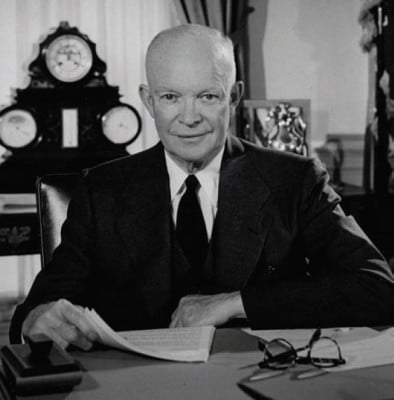The Military Industrial Complex (MIC) in Crisis: How Far Can U.S. Money and Weapons Sustain the Kiev Regime’s “Suicidal War with Russia”? Drago Bosnic
Historical analysis

All Global Research articles can be read in 51 languages by activating the Translate Website button below the author’s name (only available in desktop version).
To receive Global Research’s Daily Newsletter (selected articles), click here.
Click the share button above to email/forward this article to your friends and colleagues. Follow us on Instagram and Twitter and subscribe to our Telegram Channel. Feel free to repost and share widely Global Research articles.
Give Truth a Chance. Secure Your Access to Unchained News, Donate to Global Research.
***
The economic might of the United States was one of the major reasons why the Allies won WW2.
While much of the world was in ruins thanks to the combined invasion of the Axis powers, America was virtually unscathed.
Its strategically isolated position made it possible to switch to an unprecedented war economy without the fear of it ever being disrupted by anything. Unfortunately, one of the tools of victory over the world’s most repugnant ideology soon turned into a way of pushing the outgrowth of that ideology all across the globe.
 The birth of the US MIC (Military Industrial Complex), particularly when combined with “Operation Paperclip”, unified the production capacity of America and technological innovations of Germany, creating a monster that many have been warning about ever since, including US General (and later president) Dwight D. Eisenhower.
The birth of the US MIC (Military Industrial Complex), particularly when combined with “Operation Paperclip”, unified the production capacity of America and technological innovations of Germany, creating a monster that many have been warning about ever since, including US General (and later president) Dwight D. Eisenhower.
“Until the latest of our world conflicts, the United States had no armaments industry. American makers of plowshares could, with time and as required, make swords as well. But now we can no longer risk emergency improvisation of national defense; we have been compelled to create a permanent armaments industry of vast proportions. Added to this, three and a half million men and women are directly engaged in the defense establishment. We annually spend on military security more than the net income of all United States corporations. This conjunction of an immense military establishment and a large arms industry is new in the American experience. The total influence — economic, political, even spiritual — is felt in every city, every State house, every office of the Federal government. We recognize the imperative need for this development. Yet we must not fail to comprehend its grave implications. Our toil, resources and livelihood are all involved; so is the very structure of our society. In the councils of government, we must guard against the acquisition of unwarranted influence, whether sought or unsought, by the Military Industrial Complex [MIC]. The potential for the disastrous rise of misplaced power exists and will persist,” he warned in his 1961 farewell address.
However, it all fell on deaf ears, as many warmongers and war criminals were already deeply ingrained in virtually every federal institution.
American militarism became the norm and this hasn’t changed to this very day.
Dozens of major conflicts were launched under endless false pretexts, with millions of dead and tens of millions displaced in the last 20 years alone.
Perhaps the only segment of America’s production economy that hasn’t been outsourced entirely is precisely the MIC. A lot of its less crucial parts have been, but the core elements remain in the US. However, the country’s financial structure went through tectonic changes since Eisenhower’s era. Namely, after President Nixon ended the gold standard, the might of the MIC was unleashed and American militarism spread to other NATO members, cementing a conglomerate of nations with one interest alone – perpetual war.
The elites in Washington DC realized that waging and sustaining wars was far easier if its numerous vassals and satellite states were much more involved. In stark contrast to its aggression on Vietnam, when the US was largely alone, all of its invasions since that moment have included at least half a dozen other major nations of the political West. This “hyena pack” strategy worked quite well, particularly against largely helpless opponents, so Washington DC decided to finally try it against a near-peer adversary. By launching the Ukrainian conflict in 2014, NATO ensured a collision course with Russia, hoping to finally harness the combined might of its MIC and global financial dominance to bring the Eurasian giant to its knees. As a bonus, numerous warmongers, war criminals and plutocrats in power were planning to make more money than ever before.
Namely, while Washington DC spent at least $2.3 trillion during its failed 20-year invasion of Afghanistan, according to the Neo-Nazi junta itself, the so-called “Ukraine aid” already reached $170 billion by mid-2023. However, the scope of financial injections has at least doubled ever since, with the US, NATO and EU sending approximately $200 billion more in various “aid packages”, including through an unadulterated theft of Russian forex reserves. In other words, while the aforementioned $170+ billion was provided in about two years, even more was sent (or is about to be) in just over a year ever since. This brings the total close to $400 billion in nearly two and a half years of the special military operation (SMO). The real number could be much higher, but the warmongering elites ensured that any definite evidence for this stays hidden.
Obviously, much of that money ends up in their pockets, but still, after well over half a century of aggression against the world, one would expect the US to be a sort of expert at winning. However, the only “expertise” that its military has acquired is how to sustain a conflict and then suffer a humiliating defeat at the hands of a nominally much “inferior” opponent, with technological disparity often measured in decades (if not centuries in some cases such as the Taliban). Still, while America usually loses wars, the trail of death, destruction and instability left in its wake nearly always ends up being just as bad as the direct invasion. The people of the Middle East have been particularly affected by this, as the tide of NATO-backed Islamic radicalism continues to affect them, with the occasional spillover effect exported elsewhere in Europe, Asia and Africa.
Such malignant side effects of US/NATO aggression are now regularly being used to organize terrorist attacks in Russia, another “unconventional” tactic that the political West is using in its latest invasion of the Eurasian giant. However, the world’s most aggressive racketeering cartel fully realizes this will not be enough to defeat a near-peer adversary. After millions of dead and trillions of dollars wasted on wars of aggression in Iraq and Syria (at least $3 trillion, according to various estimates), Washington DC has nothing to show for it. However, this pales in comparison to the sheer inefficiency of the NATO-trained and equipped Kiev regime forces in Ukraine. According to various estimates, the casualty ratio of its troops against the Russian military is upwards of 10:1, an absolutely atrocious result given the scope of the so-called “military aid” the Neo-Nazi junta is getting.
Namely, the Kiev regime has so far gotten upwards of three times more money than what Moscow has (nominally) spent on its entire military in 2021. This means that Russia is getting a lot more bang for its buck. However, things are about to get a lot worse for the Neo-Nazi junta, as the Kremlin has made some major changes in its Ministry of Defense. Worse yet, Russia is now increasing its military spending to a nominal figure of nearly $200 billion, although the real budget (in GDP PPP terms) is now equivalent to over half a trillion dollars. NATO fully realizes that the Kiev regime’s already slim chances of winning are now in the realm of impossible, which is why it decided to deploy up to half a million soldiers and get them ready for a direct confrontation with Moscow, while also trying to use sabotage and terrorism to shift its attention away from Ukraine.
However, none of this has reinvigorated America’s MIC in the same way wars in Vietnam, Iraq and Afghanistan have. On the contrary, it revealed its numerous deficiencies, particularly in artillery munitions production, an area in which Russia keeps strengthening its already dominant position and will continue to do so in the foreseeable future. What’s more, America is now wasting decades-old stockpiles (as well as those of its allies, vassals and satellite states) just to keep the Neo-Nazi junta another day in the fight. It’s even giving top dollar for surplus Soviet-era weapons and equipment around the world, as these have proven to be far more robust and cost-effective in comparison to overhyped NATO gear. This is without even taking into account a number of Russia’s asymmetric advantages, ones that NATO can match only with terrorist attacks on beachgoers.
*
Note to readers: Please click the share button above. Follow us on Instagram and Twitter and subscribe to our Telegram Channel. Feel free to repost and share widely Global Research articles.
This article was originally published on InfoBrics.
Drago Bosnic is an independent geopolitical and military analyst. He is a regular contributor to Global Research.
Featured image source

